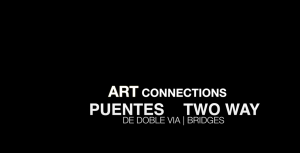The project produced a number of audiovisual pieces. See all the student products in our Collaborative Videography page.
In addition, two documentary films have been produced by the TWO WAY BRIDGES project:
ART CONNECTIONS: the Two Way Bridges | Puentes de Doble Vía and Border Crossing 101. Also, twelve short films were produced by teams of students (Latino and non-Latino) as part of the process. If you or your institution are interested in screening or accessing them please contact us. mlr34@duke.edu

ART CONNECTIONS: TWO-WAY BRIDGES|PUENTES DE DOBLE VIA. Mauricio Andrada, Miguel Rojas-Sotelo/ 30 min / Durham / 2015 (Spanish-English)
NC has become a pole of immigration. For the past decade, hundreds of thousands of Central and South American migrants have arrived. Many came as children, a generation of young undocumented Latinos is graduating from high school; they do not find space in the social fabric of their new nation. Art Connections documents a project that established a temporary bridge between the Latino community and a university while provoking privileged students to engage with peers and the surrounding community. Through public art, film, and language students embark on a journey of acceptance, sharing, realization, and community building.
Featuring visual artist Cornelio Campos, professor Bethzaida Fernández, latino youth Marco, Sandro, and Stefanía, and US youth Hannah and Josh, among others.
&

Border Crossing 101. Charles Thompson / 30 min / Durham / 2015 (English)
As part of the Two Way Bridges | Puentes de Doble Vía project, fifteen students in a Duke University class, entitled “The U.S./Mexico Border,” explore the meaning of borders, immigration, and access to education in America. Four of them are non-students and non-citizens. They act, for a semester, as if barriers to their education no longer exist. “Border Crossing 101” follows the lives of the four “guest” students, along with the eleven who go through the semester with them. Throughout the semester, class members explore their diverse pasts, gaining insights into citizenship, entitlement, and identity in America. In the end, the students have broken down personal barriers and stereotypes, but one major barrier remains.